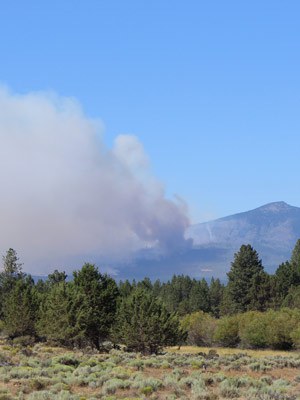An interview with NW Incident Management Team 8 Operations Chief and Deschutes Land Trust volunteer, Rod Bonacker
When a fire burns in a place that has already recently burned, does it usually burn better or worse?
It depends on how the first fire burned. Factors to consider include: how long ago the first fire burned, what it burned, and what has grown back.

Are there names for different patterns that fires have?
No, although oftentimes you will hear reference to "Mosaic" burns, which simply means there is a complicated pattern of live and dead trees or you might hear a fire referred to as “Stand Replacement,” which means the majority of the trees in the area have been killed.
Can you explain fire containment lines? Are they generally successful? What enables/helps a fire to jump the containment line?
Fire containment lines may be natural such as rivers or rocky slopes or existing barriers such as roads, or they may be constructed by hand (handline) or by machine. Occasionally, we can create a temporary containment line with water or fire retardant.
Containment lines are meant to stop the spread of the fire in the direction it is going, but they are not always successful. The lines may not be wide enough for the existing fire behavior and spot fires are commonly a problem because embers can be carried by wind as far as one mile away, creating new fires.
Once a fire has been established, what are the top factors/forces that keep it burning?
Fires need fuel (trees, shrubs, grasses). They need oxygen in the form of wind and they need heat in the form of temperature and reduced humidity. All of these things contribute to fire spread. Topography can also be a factor as fires tend to move fast upslope.
Regarding the Whitewater fire: how does a lightning strike smolder in a tree for almost a month?!?
Well, the Whitewater fire ignition was detected quickly, shortly after the lightning storm passed through. See Inciweb for detailed fire information, maps and photos from the Teams on site: https://inciweb.nwcg.gov/incident/5420/.
But it’s true that fires can smolder for long periods of time if they get into the right environment, which is typically the base of the tree. Lightning can travel down to the tree roots underground and smolder as long as it has some oxygen getting to it to maintain the fire. Then warmer weather, wind, and decreasing humidity can bring it to life.
Are fire lookout towers still used by the Forest Service in Oregon? What other methods of detecting fire are used?
They are not as common as they once were, but there are still many active lookouts in Oregon. Black Butte in Sisters is one of the most prominent, but in Central Oregon we also have lookouts at Lava Butte, Round Mountain, East Butte, Walker Mountain, Odell Butte, Hinkle Butte (right above Camp Polk), and Wolf Mountain, plus several other places.
Fires are also commonly detected by fixed wing airplane patrols and occasionally by citizens who see smoke and call it in. Another method that is getting more prominence is the use of fixed cameras and remote detection systems where cameras are placed on high spots, and then transmit to a central viewing room where electronic equipment senses changes in the viewing picture and triggers an alarm for a human to come look at them to see if it is a bird or an airplane or, in fact, is smoke.
Is there anything else you can tell us about wildfires that people have been wondering about lately?
People often ask why so many fires are allowed to go on unstaffed and unchecked for so long. The answer is that the sheer number of wildfires and the timing can overwhelm the available forces. Priorities have to be set based on property and lives at risk versus resources at risk, and then suppression resources are assigned to the fires that have the highest priority, leaving many other fires unstaffed.
People also often say we need more air tankers and helicopters to put the fires out. Air tankers or helicopters with water and fire retardant cannot put fires out acting alone. Retardant is just that--it retards the spread of the fire for a short time. To stop a fire, it still requires somehow breaking the continuity of fuels, be it fire lines made by people or machines. Fires will burn until either a massive weather change or until they are physically dug up and extinguished with water by people. Airtankers and helicopters can give you more time, but used alone, they do not put out fires.
Thank you for your insight, Rod!


